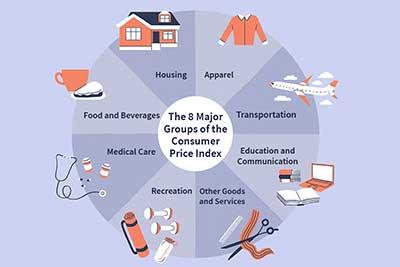Date : 14/07/2023
Relevance – GS Paper 3 – Economy – Inflation
Keywords – CPI basket, inflation calculation, Consumption Expenditure Survey (CES), prompt action, cost of living, poverty line determination
Context –
The analogy of an antique store serves as a relevant comparison to highlight the impact of outdated items in the Consumer Price Index (CPI) basket on the calculation of inflation.
The Antique Store Analogy
In an antique store, you come across old items like wooden trunks and radios that were once cutting-edge technology. This scene serves as a metaphor for tracking the Consumer Price Index (CPI) and calculating inflation in India. The current CPI basket includes outdated items like torches, radios, tape recorders, CDs, DVDs, and trunks, which no longer reflect our modern consumption patterns.
The Flawed CPI Basket: Need for Adaptation
The CPI basket should not be seen as an unchangeable artifact frozen in time. It should evolve with the shifting needs, preferences, and economic conditions of society. However, the current CPI weights are outdated, with an excessive focus on food and minimal consideration for non-food items like housing, education, healthcare, and digital services. This imbalance fails to capture the changing spending patterns of individuals as their income rises, as observed in Engel's Law.
Excessive Weight on Cereals and Other Issues
The current CPI assigns a disproportionately high weight to cereals, which is excessive given the diversification of dietary habits and government schemes that reduce cereal expenditure. Additionally, other items like tomatoes, onions, and potatoes have a considerable impact on inflation but are not adequately represented in the CPI. These issues highlight the need for a more accurate reflection of changing consumption patterns.
Challenges in Reflecting Consumption Patterns
Effectively reflecting changes in inflation metrics requires up-to-date consumption expenditure data. However, the Ministry of Statistics and Programme Implementation (MoSPI) faces challenges in accessing this data, leading to delays in updating the CPI. The ongoing Household Consumption Expenditure Survey (CES) aims to address this, but the processing times are lengthy, hindering the creation of a new CPI based on fresh data.
The Predicament and Necessity for Prompt Action
As a result, we find ourselves relying on outdated parameters for measuring inflation. This poses a significant challenge in accurately assessing the cost of living and economic well-being in a rapidly evolving digital economy. The absence of updated CES data affects poverty line determination and undermines our ability to track inflation effectively. MoSPI must address these gaps promptly and prioritize efficient data processing to ensure our tools for understanding and managing our economic reality are adequate.
Conclusion: Adapting to Modern Consumption Patterns
To accurately reflect the realities of modern-day consumption and living, it is imperative to update the CPI and inflation estimation methods. Prompt action, including incorporating the findings of the CES and improving data processing, is necessary to ensure that our metrics align with the evolving economy and consumer behavior. By doing so, we can better understand the cost of living, and economic well-being, and make informed policy decisions.
Probable Questions for UPSC Mains Exam –
- Discuss the challenges and shortcomings of the current Consumer Price Index (CPI) and its implications for accurately measuring inflation in India. Suggest measures to address these issues. (10 Marks, 150 words)
- “The reliance on an outdated CPI basket and inflation calculation methodology hampers our ability to accurately understand and manage our economic reality." Analyze this statement and propose suitable strategies to ensure the CPI accurately reflects the changing consumption patterns and economic conditions in India. (15 Marks, 250 words)
Source: The Hindu







